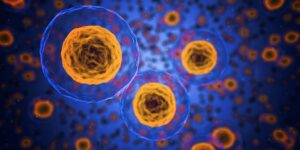
Image by PublicDomainPictures from Pixabay
From the time we started testing Jessica’s stool she had high levels of lactoferrin. On the lab test itself in the description is says that high levels of lactoferrin could be from IBD. Because her labs showed this, we thought Jessica had IBD for quite a long time. The doctor told us it was not precursors to IBD but it WAS IBD and the lab showed this and confirmed what she said, or so we thought. So, I became laser focused on lactoferrin in a negative way. I did not see high lactoferrin levels as positive.
When I stopped breastfeeding Jess’s lactoferrin levels went to the normal range. We went to see a gastroenterologist and he didn’t seem that concerned about lactoferrin, but more concerned with whether she had high levels of calprotectin, which he said would be a better indicator of IBD. He did say that the elevated lactoferrin, “is likely the results of some other intercurrent illness.”
For the longest time I thought that the lactoferrin being high was a bad thing but it may have been addressing issues in Jessica’s dysregulated immune system at that time. Looking back now, I think it was likely the mycotoxins and being exposed to high levels of toxic mold that may have caused much of what we were dealing with. After looking at the following studies and information about lactoferrin and also having Dr. H recommend giving Jessica a supplement of lactoferrin, I plan to try this to see if it would raise her SIgA, help eliminate the elevated bad bacteria in her gut, and even help eliminate some of the other internal toxins. We will see how this all works out.
Lactoferrin acts as an antiviral
Since the 1990s, the list of Lf-susceptible pathogenic human viruses found to be inhibited by Lf have expanded to include naked and enveloped viruses as well as DNA and RNA viruses (Table 1 ), including cytomegalovirus, herpes simplex virus, human immunodeficiency virus (HIV), rotavirus, poliovirus, respiratory syncytial virus, hepatitis B virus, hepatitis C virus (HCV), parainfluenza virus, alphavirus, hantavirus, human papillomavirus, adenovirus, enterovirus 71, echovirus 6, influenza A virus and Japanese encephalitis virus, https://www.ncbi.nlm.nih.gov/pmc/articles/PMC7390755/
Lactoferrin also acts as an immune modulator and anti-inflammatory.
Lf is a unique multifunctional moiety that is not only a broad-spectrum antiviral but also has immunomodulatory [23] and anti-inflammatory [24] actions that may play a role in the pathophysiology of severe infections. https://www.ncbi.nlm.nih.gov/pmc/articles/PMC7390755/
From the article entitle The Biology of Lactoferrin, an Iron-Binding Protein That Can Help Defend Against Viruses and Bacteria:
Bacteria and lactoferrin
One of the most well-known characteristics of LF is that it is antibacterial (19, 144–148), antiviral (99, 149–151), antifungal (152–154), anti-inflammatory (26), and anti-carcinogenic (155). Its ability to of limit iron availability to microbes is one of its crucial amicrobial properties. https://www.ncbi.nlm.nih.gov/pmc/articles/PMC7271924/
Lactoferrin is a naturally occurring protein found in milk and bodily fluids. It is a potent anti-microbial and modulator of the immune system. As a supplement, lactoferrin may improve iron status, skin health, immunity, and more.
What is Lactoferrin?
Lactoferrin (also known as lactotransferrin or LF) is a type of iron-binding glycoprotein that is mostly secreted from bodily fluids including milk, saliva, tears, vaginal fluids, semen, secretions from lungs and nose, bile, digestive juices, and urine.
It provides antibacterial and immune-supporting activity to human infants. LF is a component of the immune system responsible for defense at the mucosal level, due to its high antimicrobial activity.
Lactoferrin is also found in secondary neutrophil granules, blood, and amniotic fluid. It also binds to DNA and other molecules in milk like IgA, casein, albumin, etc. https://pubmed.ncbi.nlm.nih.gov/27690059/; https://www.ncbi.nlm.nih.gov/pmc/articles/PMC1793702/pdf/archdisch00638-0105.pdf.
Lactoferrin is crucial to the increase in immune functions for breastfed infants. It is also believed to be widely important to maintaining immune functions further in life past infancy.
It helps develop the gastrointestinal and immune system in newborns. https://pubmed.ncbi.nlm.nih.gov/27234407/.
Skeptics:
High doses may cause digestive upset
Supplementation is not well studied in humans
Marker of Inflammation and Infections
Lactoferrin kills bacteria and protects from infections. Therefore, natural lactoferrin levels in our bodies rise during times of infections and inflammation.
To combat bacterial infections, blood lactoferrin rapidly rises and iron levels drop during E. coli infection in the blood in mice. Doctors test lactoferrin in the stool to detect inflammation in the intestines, especially to diagnose inflammatory bowel disease. Lactoferrin is protein released by a type of white blood cell called a neutrophil. When there is inflammation in the digestive tract, neutrophils are attracted to the area and release lactoferrin, increasing the level of the protein in the stool. This test measures the level of lactoferrin in stool as a way to detect inflammation in the intestines. https://www.testing.com/tests/lactoferrin/.
Antioxidant Properties
Because iron can cause oxidative stress, lactoferrin can reduce oxidative stress by binding and removing iron, which prevents cell damage or cell death. https://www.ncbi.nlm.nih.gov/pmc/articles/PMC2915836/.
Lactoferrin supplementation can support the immune system as an antioxidant. https://pubmed.ncbi.nlm.nih.gov/19083463/.
Roles in Immunity
There are lactoferrin receptors on many immune cells, so lactoferrin directly affects how these cells function. “Modulating immune function.” https://pubmed.ncbi.nlm.nih.gov/16261254/. “Several studies suggest biological functions of the iron-binding neutrophilic glycoprotein lactoferrin that imply an initial interaction with cells from the monocyte/macrophage family.” https://pubmed.ncbi.nlm.nih.gov/7762450/.
Lactoferrin can exert changes on white blood cells, through increasing natural killer cell, neutrophils, and macrophage activities. This increases cytokine, and Nitric Oxide production as well as limit pathogen growth. “Lactoferrin is an iron-binding glycoprotein implicated in particular in the control of immune functions and cell proliferation.” https://pubmed.ncbi.nlm.nih.gov/9606986/. “Bovine LF (bLF) at concentrations in the range of 50-250 micrograms/ml enhanced the phagocytic activity of human neutrophils.” https://pubmed.ncbi.nlm.nih.gov/9682001/. “Lactoferrin (LF) is an iron-binding protein found in milk, mucosal secretions, and the secondary granules of neutrophils in which it is considered to be an important factor in the innate immune response against microbial infections.” https://www.ncbi.nlm.nih.gov/pmc/articles/PMC2276410/.
Lactoferrin also affects adaptive immune cells (T-cells and B-cells).
In infants, lactoferrin is crucial to the development of their natural immune system function to prevent infection. “These randomized controlled trials demonstrate that lactoferrin has a clinically significant impact on feeding, the microbiome, and clinical outcomes in neonates and infants.” https://pubmed.ncbi.nlm.nih.gov/27234411/.
Anti-Inflammatory Effects
Although the direct mechanism has not been established yet, lactoferrin is a well-known anti-inflammatory component in humans. “Lactoferrin is also a prominent component of the secondary granules of neutrophils (PMNs) and is released in infected tissues and blood during the inflammatory process…At the cellular level, lactoferrin modulates the migration, maturation and function of immune cells. At the molecular level and in addition to iron binding, interactions of lactoferrin with a plethora of compounds, either soluble or membrane molecules, account for its modulatory properties.” https://pubmed.ncbi.nlm.nih.gov/16261255/.
Lactoferrin in the amniotic fluid is an important component to reducing fetal inflammation in pregnant women through reducing IL-6 levels and reducing infection causing the inflammation. “These results show conclusively that LF suppresses amniotic IL-6 production under the conditions of intrauterine infection.” https://selfhacked.com/blog/lactoferrin/.
It has anti-inflammatory properties when interacting with the immune system against the Epstein-Barr virus, reducing inflammation by inhibiting the activation of TLR2 and TLR9 in the virus DNA. “These findings suggest that LF may suppress the EBV-induced inflammatory response through interfering with the activation of TLR2 and TLR9.” https://pubmed.ncbi.nlm.nih.gov/25068657/.
Antibacterial Properties
Lactoferrin helps stop the activity of bacteria. Most bacteria need iron to function, and lactoferrin can stop bacteria from taking up iron in the human body. https://www.ncbi.nlm.nih.gov/pmc/articles/PMC1793702/pdf/archdisch00638-0105.pdf.
In addition to this, it can block bacteria’s carbohydrate metabolism, destabilize their cell walls, or interact with lysozymes in milk to stop bacteria. https://www.ncbi.nlm.nih.gov/pmc/articles/PMC1793702/pdf/archdisch00638-0105.pdf.
Roles in Fetal/Infant Development
Infants require lactoferrin to develop and adapt to the intestinal system. It is responsible for differentiating small intestinal epithelial cells, affecting small intestinal mass, length, and enzyme expression. “Lactoferrin (Lf) is among the various human milk trophic factors that facilitate the infant intestinal adaptation… native bovine Lf can perform biological activities similar to those exerted by human Lf in postnatal small intestinal development.” https://pubmed.ncbi.nlm.nih.gov/22332905/.
In human fetuses, LF promotes iron absorption and development of the brush border, allowing for healthy growth and gut development before birth. “These results suggest that the brush-border membrane receptor for human Lf may be responsible for the high iron absorption from human milk.” https://pubmed.ncbi.nlm.nih.gov/1659221/.
High levels of LF in the fetus prevent infection and ruptures of fetal membranes while increasing the ease of labor. “We propose that lactoferrin is part of the repertoire of host defense mechanisms against intra-amniotic infection.” https://pubmed.ncbi.nlm.nih.gov/11035335/. The above studies and words were adapted from https://selfhacked.com/blog/lactoferrin/
Lactoferrin: a modulator of immune and inflammatory responses
Abstract
Lactoferrin is an iron-binding glycoprotein of the transferrin family. Abundant expression and secretion of lactoferrin, in particular in milk and fluids of the digestive tract, are related to its implication in the first line of host defense. Lactoferrin is also a prominent component of the secondary granules of neutrophils (PMNs) and is released in infected tissues and blood during the inflammatory process. In addition to its direct antimicrobial properties, the abilities of lactoferrin to regulate the immune response and to protect against infection and septic shock have been described in numerous in vitro and in vivo studies. Although the cellular and molecular mechanisms that account for the modulation of the inflammatory and immune responses by lactoferrin are not yet totally elucidated, many are now established. At the cellular level, lactoferrin modulates the migration, maturation and function of immune cells. At the molecular level and in addition to iron binding, interactions of lactoferrin with a plethora of compounds, either soluble or membrane molecules, account for its modulatory properties. https://pubmed.ncbi.nlm.nih.gov/16261255/
Clinical Benefits of Lactoferrin for Infants and Children
Abstract
To discuss the potential clinical benefits of lactoferrin in preterm and term infants, as well as in young children and to review information on the burden of neonatal sepsis. Current evidence on the mechanisms that explain the role of human milk in the neonatal and infant anti-infective responses will be briefly reviewed and preclinical research data on the potential mechanisms of action by which lactoferrin may impact infant gut health, gut immune development and functions, including the lactoferrin effects on the neonatal microbiome, will be examined…These randomized controlled trials demonstrate that lactoferrin has a clinically significant impact on feeding, the microbiome, and clinical outcomes in neonates and infants. https://pubmed.ncbi.nlm.nih.gov/27234411/
Inhibition of growth of Pneumocystis carinii by lactoferrins alone and in combination with pyrimethamine, clarithromycin and minocycline
Abstract
The in vitro activity of lactoferrins alone and in combination with clarithromycin, minocycline and pyrimethamine was investigated against three clinical isolates of Pneumocystis carinii…Lactoferrins at 20 mg/L combined with clarithromycin 4 mg/L had high anti-P. carinii activity, with a >90% decrease in cystic and trophic form counts. Our study suggests that lactoferrins may inhibit P. carinii growth in vitro and act synergically with other clinically used compounds. These findings lend experimental support to the use of iron-chelating agents in the therapy of pneumocystis infections. https://pubmed.ncbi.nlm.nih.gov/11020255/
WebMD
Lactoferrin helps regulate how well iron is absorbed into the body from the intestine. It also seems to protect against infections from bacteria, viruses, and fungi. Lactoferrin seems to slow down the growth of bacteria by starving them of nutrients. It also destroys the walls around the bacteria. The lactoferrin contained in mother’s milk is thought to help protect breast-fed infants against infections. https://www.webmd.com/vitamins/ai/ingredientmono-49/lactoferrin

